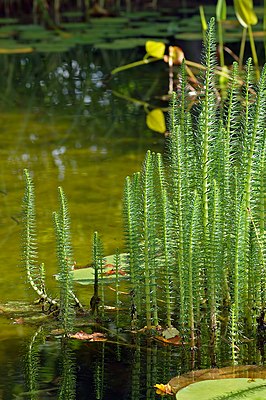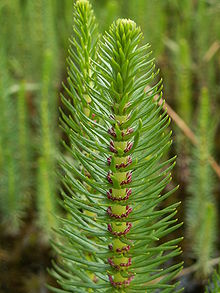Ordinary fir frond
| Ordinary fir frond | ||||||||||||
|---|---|---|---|---|---|---|---|---|---|---|---|---|

Fir fronds ( Hippuris vulgaris ) |
||||||||||||
| Systematics | ||||||||||||
|
||||||||||||
| Scientific name | ||||||||||||
| Hippuris vulgaris | ||||||||||||
| L. |
The Ordinary mare's tail ( Hippuris vulgaris ), also Common mare's tail called, is a plant of the genus mare's tail ( Hippuris ) within the family of plantain plants (Plantaginaceae). It bears its common German name Tannenwedel because of its resemblance to a small fir tree. Although the plant looks like a horsetail , it belongs to the seed plants and is not related to the horsetail family.
description
Vegetative characteristics
The appearance of the common fir frond is very variable, as it develops not only completely submerged deep-water forms but also land forms living on dry land and transitional forms between these two extremes. The rhizome grows creeping, horizontally in the mud. Numerous, hollow and unbranched stems grow out of it, some of which protrude above the water.
The common pine frond has dark green, needle-like leaves, the topmost of which protrude up to 40 centimeters from the water. The leaves hang limply under water, are thin, soft and ribbon-like. In contrast, foliage leaves above the water surface are horizontally stiffly protruding. The plant is green even in winter.
Generative characteristics
Flowers are only developed above the water surface. The small flowers, arranged individually in the axes of the leaves, are mostly hermaphroditic , but due to stunting they can also be unisexual. The flowers are reddish-brown, inconspicuous and reduced; they have sepals but no petals. The single stamen has a reddish anthers . The only carpel is underneath.
The stone fruit contains only one seed. The elongated, single-seeded closing fruit has a strong stone shell and thin "meat".
The number of chromosomes is 2n = 32.
ecology
The common fir frond is a z. T. flooding, then up to about 1 m long water plant , or 10 to 15 centimeters high, amphibian living marsh plant rooted at the bottom of the water body, or in moist soil with one, sympodial branched rhizome . The stem has an aerenchyma . Vegetative reproduction occurs through runners and turions .
The flowers stand on parts of the rungs protruding from the water and are wind- blooming of the "immobile type". The pollination is carried by the wind.
They are subject to the digestive spread e.g. B. by birds , as well as the swimming spread.
Occurrence
Hippuris vulgaris is found in Europe , Western Asia , North America , Greenland and southern South America ( Chile ). Since it is used as an ornamental plant for garden ponds, artificial settlements must be assumed for some occurrences in the field.
The fir frond thrives best in sunny to partially shaded locations in 20 to 50 centimeters deep, standing or slowly flowing, nutrient-rich and lime-rich waters. The waters should be warm in summer and have a muddy bottom . It occurs in Central Europe in the plant communities Potamogetonetalia and Phragmition.
Systematics and related species
The first publication of Hippuris vulgaris was in 1753 by Carl von Linné .
The genus Hippuris L. was placed in a separate family of fir-tail plants (Hippuridaceae). After APG this genus belongs to the family of the way Erich plants (Plantaginaceae).
In addition to Hippuris vulgaris , another species can be distinguished in the genus Hippuris :
- Hippuris tetraphylla L. f. : It occurs in Europe, North America, Japan and northeastern Inner Mongolia. It differs from Hippuris vulgaris by the shorter leaves, which are in whorls of four and not eight to twelve. In Europe, Hippuris tetraphylla is found in Iceland, Norway, Sweden, Finland and Russia.
use
The fir frond is used as an ornamental plant for pond edges and wild plant gardens.
literature
- Elfrune Wendelberger: Plants of the wetlands - waters, moors, floodplains , Gutenberg Book Guild , Munich 1986, ISBN 3-7632-3265-6 (or BLV-Verlag, ISBN 3-405-12967-2 )
- Gerald Thompson, Jennifer Coldry, George Bernard: Der Teich , Kosmos Verlag, Stuttgart 1986, ISBN 3-440-05670-8
- Ruprecht Düll , Herfried Kutzelnigg : Pocket dictionary of plants in Germany and neighboring countries. The most common Central European species in portrait. 7th, corrected and enlarged edition. Quelle & Meyer, Wiebelsheim 2011, ISBN 978-3-494-01424-1 .
- Jiarui Chen, Michele Funston: Hippuridaceae. Hippuris Linnaeus. - Same text online as the printed work , In: Wu Zheng-yi, Peter H. Raven, Deyuan Hong (Ed.): Flora of China. Volume 13: Clusiaceae through Araliaceae. Science Press and Missouri Botanical Garden Press, Beijing and St. Louis, 2007, ISBN 978-1-930723-59-7 .
Individual evidence
- ↑ a b c d e Jiarui Chen, Michele Funston: Hippuridaceae. Hippuris Linnaeus. - Same text online as the printed work , In: Wu Zheng-yi, Peter H. Raven, Deyuan Hong (Ed.): Flora of China. Volume 13: Clusiaceae through Araliaceae. Science Press and Missouri Botanical Garden Press, Beijing and St. Louis, 2007, ISBN 978-1-930723-59-7 .
- ↑ a b Erich Oberdorfer : Plant-sociological excursion flora for Germany and neighboring areas . With the collaboration of Angelika Schwabe and Theo Müller. 8th, heavily revised and expanded edition. Eugen Ulmer, Stuttgart (Hohenheim) 2001, ISBN 3-8001-3131-5 , pp. 692 .
- ↑ Pertti Johannes Uotila, 2009+: Hippuris. : Datasheet Hippuris In: Euro + Med Plantbase - the information resource for Euro-Mediterranean plant diversity.
Web links
- Hippuris vulgaris L., common pine frond. In: FloraWeb.de.
- Profile and distribution map for Bavaria . In: Botanical Information Hub of Bavaria .
- Ordinary fir frond . In: BiolFlor, the database of biological-ecological characteristics of the flora of Germany.
- Hippuris vulgaris L. In: Info Flora , the national data and information center for Swiss flora . Retrieved December 30, 2015.
- Distribution in the Netherlands. (Dutch)
- Distribution map in the northern hemisphere.
- Thomas Meyer: Data sheet with identification key and photos at Flora-de: Flora von Deutschland (old name of the website: Flowers in Swabia ).

